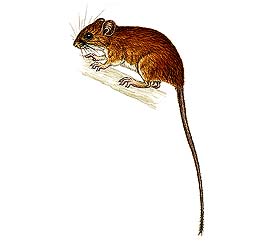Guianan squirrel
Guianan SquirrelSciurus aestuans Makushi name: Kari Creole name: Squirrel Size: body=20 cm; tail=17 cm; weight=450 g Description: Together with other tree squirrels, it has large eyes, long, bushy tail, and long toes with claws. Medium-sized. Back and head are grizzled, dark reddish brown, with pale eye ring; belly greyish-orange; dark tail edged in yellowish-orange. The largest squirrel in Guyana. Activity: Diurnal, arboreal. Habits: Usually solitary, sometimes occurs in pairs. Most often seen in middle or lower levels of trees where it forages actively for nuts, fruits, and occasionally eggs and nestling birds. When alarmed it climbs up a tree trunk (usually on the opposite side from an observer), while chattering or giving sharp chips and barks. Habitat: Primary and secondary forest, often in tree falls or tangled mats of vines. Status: Locally common. Distribution in Iwokrama

